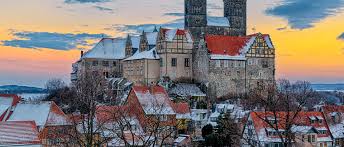Quedlinburg is the site of where Germany's first King was crowned
Quedlinburg is a magical spot. Located a few hours’ drive south of Berlin, I
visited this charming former East German village in 1990 after the wall was
demolished. I went because my grandfather was born in
Quedlinburg and I wanted to explore the paternal side of the family. It was a jewel box then and thanks to its
protected status by the United Nations (1994), it remains a precious gem today.
The town has royal beginnings. The first king of Germany, Henry (876-936),
was crowned in Quedlinburg and the town became the first capitol of the newly
formed German Republic. One of the most
highly esteemed churches in Germany during the Middle Ages was built at the top
of the hill in Quedlinburg to honor its position as the epicenter of Germany. The town prospered due to considerable wealth
and political influence brought by its importance as a trading center in the
Middle Ages.
The town's perfectly architecture makes it one of the most special towns in all of Germany.
The real reason to come here is for the jaw-dropping architecture. An outstanding example of a medieval town,
Quedlinburg is distinguished by its exceptional architectural heritage of
Romanesque and half-timbered buildings, many of remarkably high quality. When I visited in 1990, I was awe-struck at
how well preserved this medieval village was.
Yes, many of the buildings needed a fresh coat of paint, but its
compelling raw beauty was very apparent. Today, this Cinderella is fully dressed for
the ball.
The Christmas market is held in the enchanting central square
We rented a gorgeous apartment near the Castle and I
cooked Christmas dinner: a fennel
& herb-brined pork rib roast with a fennel and cherry relish served with a wine-braised red cabbage. A Grand Kru
Riesling from Albert Mann completed this perfect culinary composition. Although it probably wasn’t exactly the meal my grandmother
would have prepared for Christmas (goose is the most popular yule-time meal), with the fireplace crackling and a glass of Champagne to
kick it off, I think my grandparents would have indeed enjoyed themselves.
Wishing you many magical experiences in the New Year !



























